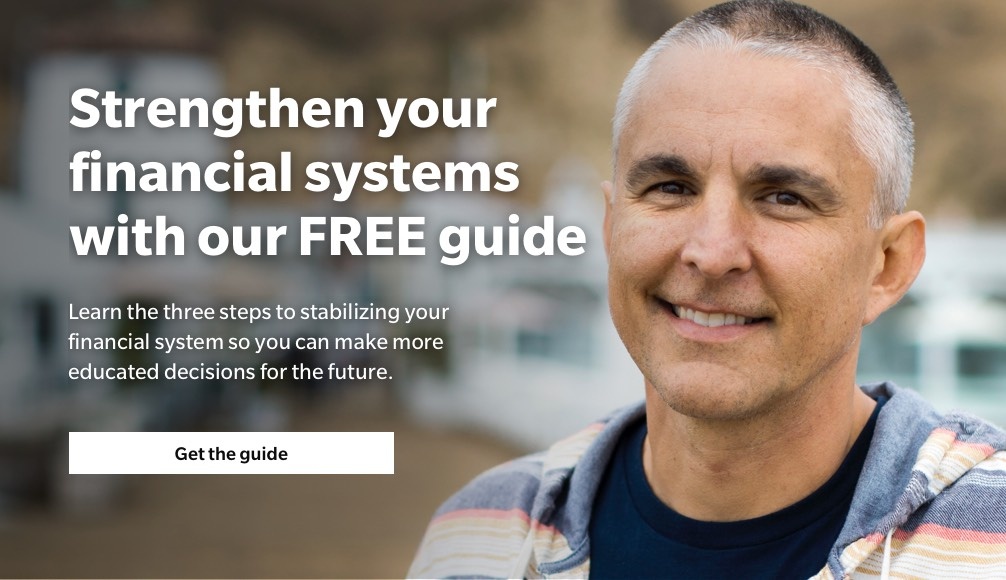If you’re like many other business owners, the mere thought of managing your finances makes you want to bury your head in the sand. You may find yourself asking, “How can I create a cash plan? Wait—what is a cash plan?” And that’s a great place to start: What exactly is a cash plan? Think about it like this: If your business is a car, cash is the gas. And sometimes, despite our best efforts, the tank hits empty before the next gas station. In order to keep driving your business toward the future you envision, a cash plan ensures that you won’t stall out.
Before you begin, it’s key to understand the difference between profit and cash flow. In other words, the difference between your revenue and expenses as you’ve anticipated versus how they’re actually flowing. You may have already encountered a scenario in which your anticipated profit remains the same even while your current cash position decreases, or maybe your net profit decreases but your cash position increases—no matter the scenario, changes to cash surplus create an immediate impact. And though your business may run unprofitably for a period of time, it won’t run this way forever. In short, your cash plan is a budget for your cash. It’s a cash flow statement for the future, including forecasts of receipts and expected disbursements in the coming months.
In order to create a sustainable and flexible cash plan, there are some vital steps to put in place. Whether you’re working in tandem with an in-house accountant, a financial advisor or going it alone, here’s an overview that’ll help get you started:
1. Set up your cash flow cycle
The whole goal of this process is to control the financial activities in your business to maximize cash flow—and to do that, you need to set a review cadence. Begin by establishing your goals based on a period of time. When will you check in to review the cash flow cycle? Weekly, bi-weekly, monthly, quarterly—or some combination? If your business is in a particularly uncertain position, you may even want to begin with daily reviews. Choose a timeline that works for you and stick with it. Use it not only to see your cash standing today, but also to look back to previous time periods and to project your future cash position.
2. Produce a cash flow statement
At the end of a cycle, generate your cash flow statement. With this, you’ll be able to review your cash position and make any adjustments you need based on the variance report. The critical formula of a cash flow statement is simple:
Cash Receipts - Cash Disbursements = Net Cash Flow
The result is a positive or negative net cash flow—that figure is your ending cash position for the cycle, as well as the beginning cash position for the next cycle’s report.
Once you have a statement set up, don’t just use it going forward. Assuming you haven’t yet created any cash flow statements, work with your accountant (or use your accounting software) to generate cash flow reports for previous cycles. Start with your beginning cash position for this cycle, then pull receipts and disbursement data from your bank account statements and your accounting software, and plug it into the columns for the previous month. Work backward until you produce cash flow statements for three, six or twelve of the previous months.
3. Forecast your cash
Remember, your cash plan is nothing more than a cash flow statement for the future, using forecasted rather than historical numbers. With that in mind, here’s another formula for you:
Projections + Predictions = Forecast
Projections are what you guess your likely sales figures will be based on previous years’ experience. Predictions, on the other hand, anticipate any possible changes in the future that could impact sales for better or worse—plans for marketing, new products or market expansion, for example.
As you forecast cash flow for future periods, you’ll need to anticipate cash receipts from your sales and from accounts receivable, and as well as other miscellaneous or occasional sources. I know, it can feel vague at first to “guess” at figures, but you’re basing this estimation on real numbers.
-
Cash from sales looks back to previous months in order to estimate an average, and take into account any upcoming factors that might affect this number. For example, say you have a seasonal business and revenue from one season vastly outweighs others. Or maybe you’re launching a highly anticipated new product or service. All of this matters.
-
Accounts receivable is a bit different. You likely know that your customers don't often pay you minute the minute they get the invoice (but wouldn’t that be nice?). Take a look at the history of your numbers with your accountant and calculate the average amount of time for collection of receivables. Ideally, you want to aim for 30 days or less. If it’s significantly slower than that, you may want to review your credit and collection policies.
-
Miscellaneous cash sources are things like interest gained, tax refunds, rental income, credit payments, etc. You should be able to predict these numbers fairly regularly and accurately. Don't worry much about predicting smaller, irregular receipts—just focus on major surprises. It’s okay to be conservative in your forecasts—having more cash than you predicted is never a bad thing! Just keep track of those numbers.
4. Review and manage your cash plan variance report
Review your cash flow on a regular basis so that you stay in the know on how things are flowing. If you end a cycle with net positive cash flow, great—you have a cash cushion for any unforeseen circumstances. And on the other end, knowing that your cash position is in the negative can help you plan ahead in other directions.
Comparing variance reports—which show the difference between your expected cash flow in and the actual income—will also paint a bigger picture of what’s going right or wrong in your business in that given period. Maybe your accounts receivable cash is lower than anticipated, so it’s time to check in with those customers or tighten up your policy. Or maybe, you see that numbers are way up in response to a new salesperson, and you know they’re the right fit for the job.
Keeping an eye on cash flow in real time is key to proactively managing budgets and staying on track with financial planning. But it’s also important to keep in mind that part of cash planning is to think about and create a cash reserve. In general, aim to determine your average monthly expenses, then build a reserve that’s 2-3 times that amount (or more depending on how big your company is). That way, your business can still run for a couple of months in case of an emergency or unforeseen circumstances. It may take several months to build that reserve up, but it's never too late to start now.
Feeling inspired to implement a cash flow system in your small business, but would like support to get started? We’re here to help.




Comments